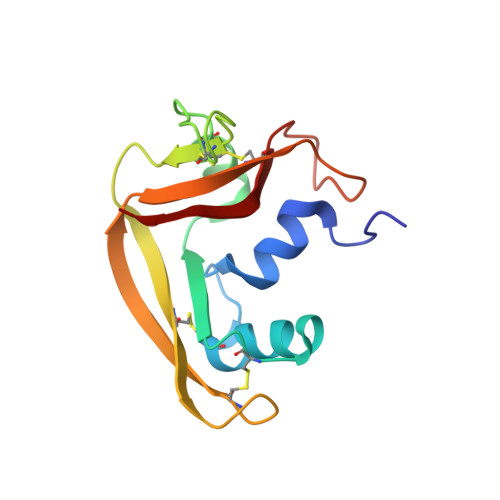The flexible and clustered lysine residues of human ribonuclease 7 are critical for membrane permeability and antimicrobial activity.
Huang, Y.C., Lin, Y.M., Chang, T.W., Wu, S.J., Lee, Y.S., Chang, M.D., Chen, C., Wu, S.H., Liao, Y.D.(2007) J Biological Chem 282: 4626-4633
- PubMed: 17150966
- DOI: https://doi.org/10.1074/jbc.M607321200
- Primary Citation of Related Structures:
2HKY - PubMed Abstract:
The ubiquitous ribonucleases (RNases) play important roles in RNA metabolism, angiogenesis, neurotoxicity, and antitumor or antimicrobial activity. Only the antimicrobial RNases possess high positively charged residues, although their mechanisms of action remain unclear. Here, we report on the role of cationic residues of human RNase7 (hRNase7) in its antimicrobial activity. It exerted antimicrobial activity against bacteria and yeast, even at 4 degrees C. The bacterial membrane became permeable to the DNA-binding dye SYTOX(R) Green in only a few minutes after bactericidal RNase treatment. NMR studies showed that the 22 positively charged residues (Lys(18) and Arg(4)) are distributed into three clusters on the surface of hRNase7. The first cluster, K(1),K(3),K(111),K(112), was located at the flexible coil near the N terminus, whereas the other two, K(32),K(35) and K(96),R(97),K(100), were located on rigid secondary structures. Mutagenesis studies showed that the flexible cluster K(1),K(3),K(111),K(112), rather than the catalytic residues His(15), Lys(38), and His(123) or other clusters such as K(32),K(35) and K(96),R(97),K(100), is critical for the bactericidal activity. We suggest that the hRNase7 binds to bacterial membrane and renders the membrane permeable through the flexible and clustered Lys residues K(1),K(3),K(111),K(112). The conformation of hRNase7 can be adapted for pore formation or disruption of bacterial membrane even at 4 degrees C.
- Institute of Biomedical Sciences, Academia Sinica, Taipei 115, Taiwan; Institute of Biochemical Sciences, National Taiwan University, Taipei 106 Taiwan.
Organizational Affiliation:
















